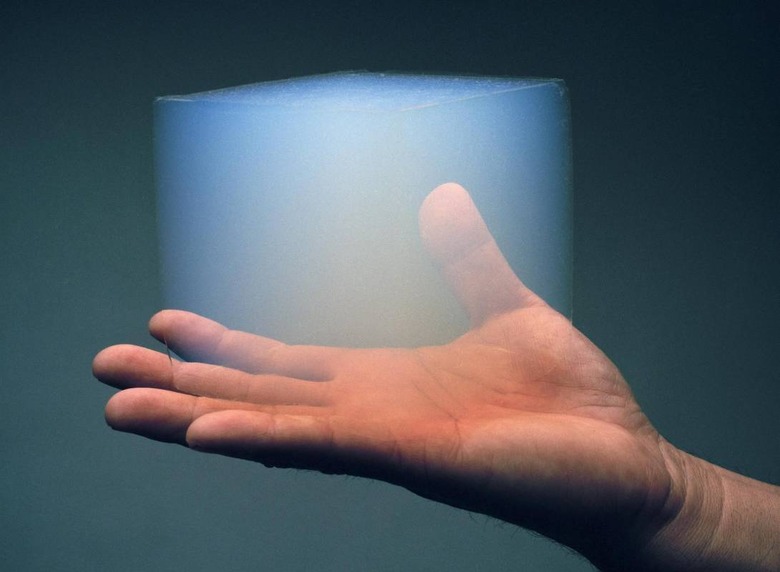This Bizarrely Light Material Could Help Terraform Mars
Ultra-lightweight materials and intentionally triggering the greenhouse effect could be the key to terraforming Mars, a team of researchers have suggested, using silica aerogels to potentially build huge biospheres served with liquid water. The red planet has a surprising store of ice locked away under its surface, but tapping into that solid reservoir has presented a headache to human colonization plans.
An intentional greenhouse effect to terraform Mars
The greenhouse effect has been one of the most significant contributors to climate change on Earth. Carbon dioxide in the atmosphere built up to form an insulating layer, trapping in heat and helping to raise temperatures. However it has a potential benefit for planets where raising the temperature is a goal, not a problem.
On Mars, where the surface temperature is typically -81 degrees Fahrenheit (-63 degrees Celsius), making conditions hotter would serve several purposes for human missions. For a start, it could make living conditions more bearable, and reduce the amount of individual insulation astronauts might need to wear in their suits, and have built into their habitats. More pressing, it could lead to the presence of liquid water.

Mars does have water already, but it's in the form of ice. Indeed, more than 5 million cubic miles of ice has been detected at, or near, the surface of the red planet, and more is believed to be present further down. Even without more discoveries, however, scientists estimate that – if melted – the known ice could cover the whole of Mars to a depth of 115 feet.
That would demand a lot more heat, however, but schemes to intentionally release carbon dioxide and other greenhouse gases on Mars and use them to warm up the planet just don't add up. There simply isn't sufficient quantities of such gases to create a thermally-insulating layer. Instead, researchers are now suggesting, we could use a more targeted approach, with a substance already familiar to NASA: silica aerogels.
Just what is silica aerogel?
Silica aerogel was already a pretty fascinating material. Most common of the aerogels, it's made up of silica solidified into a three-dimensional series of intertwined strands, or clusters. The space between them – which accounts for around 97-percent of the overall volume – is air.

What helps set it apart from other materials is how good an insulator silica aerogel can be. Since the air is trapped in "nano pores" within the cluster structure, it has minimal movement through the overall gel. As a result, both convection and gas-phase conduction are inhibited.
NASA uses silica aerogels already, for a number of purposes. Indeed, they're already on the red planet: the Mars rover relies on the material for its insulation. Other missions have used aerogels to catch high-velocity particles of interstellar dust and cometary samples, relying on the spongy structure to rapidly decelerate the impacts.
On Mars, selective aerogel terraforming
The new application, the handiwork of a team from the Harvard University, NASA's Jet Propulsion Lab, and the University of Edinburgh, would take a more targeted approach to terraforming. A shield of silica aerogel roughly an inch thick could, the scientists suggest, work as an insulator to raise the temperature of underlying ice so that it could melt, without needing a powered heat source.
At the same time, such a layer would be thin enough to transmit visible light for photosynthesis, while also blocking out hazardous levels of ultraviolet radiation.
"A system for creating small islands of habitability would allow us to transform Mars in a controlled and scalable way," Laura Kerber, Research Scientist at NASA's Jet Propulsion Laboratory, explains of the scheme. "Silica aerogel is a promising material because its effect is passive. It wouldn't require large amounts of energy or maintenance of moving parts to keep an area warm over long periods of time."
Indeed, just a thin layer of aerogel could be sufficient to raise sections of the Mars landscape to Earth-like temperatures, according to the researcher's experiments and modeling. One suggestion is that NASA's planned habitation domes – or even more ambitious constructions, such as fully self-contained biospheres – could be built in part from silica aerogels, and passively ensure liquid water for occupants.
How feasible that is will be the subject of new research, which will see aerogels trialed in Mars-like climates here on Earth. That could include Antarctica or Chile, where dry valleys are similar to the conditions on the distant planet.
